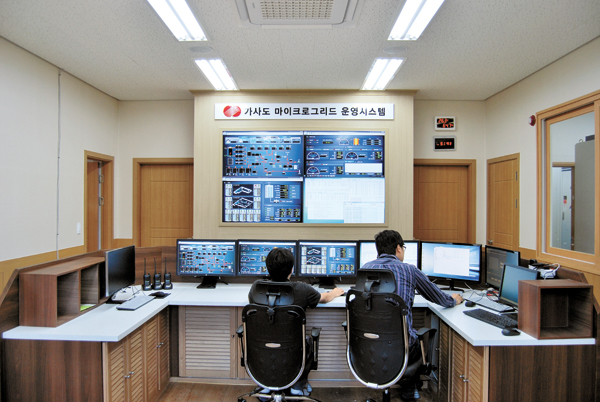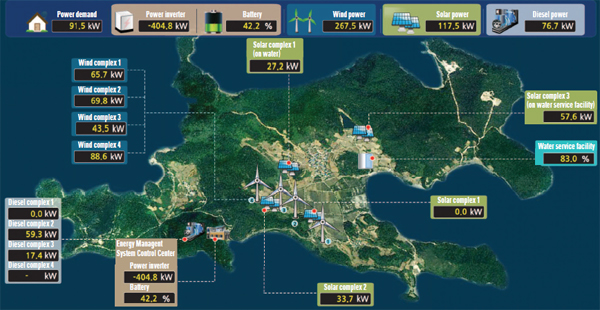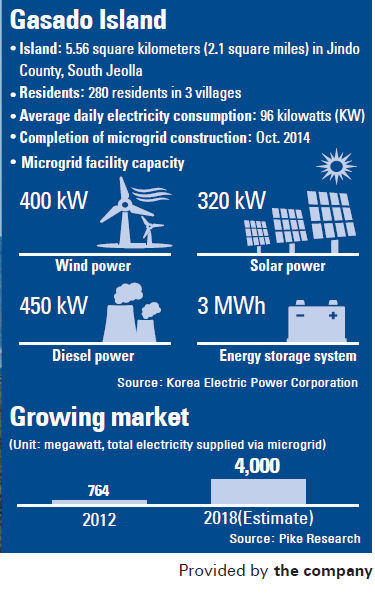Global sustainable energy starts on Korea’s islands

The wind turbine and solar panels installed on Gasa Island in Jindo County, South Jeolla. The island houses the nation’s first completely automated energy system. Provided by the company

The fully automated energy management system at the Microgrid Monitoring Center on Gasa Island. The system tracks four solar power complexes, four wind turbines and three diesel power plants in order to monitor electricity production and storage status. Depending on the level of electricity being consumed, the EMS auto-controls the power supply. Surplus is automatically stored inside the electronic storage system batteries, and stored electricity is automatically spent in cases of power shortage. Provided by the company

But after Kepco came in last October, the small island has shaved 150 million won from its power bill over the past six months.

“In the past, fishermen here have had to export our seaweed for cheap because we didn’t have enough power to sustain a drying facility,” Kim Kye-seok, a civic leader on the island, told the Korea JoongAng Daily. “We’ve had to pay other fishermen on mainland Jindo to dry and package our seaweed and fishes to sell to our Japanese buyers.
“Thanks to the microgrid facility, we have a sustainable source of electricity. So, the residents are currently preparing documents to ask Jindo County and other financial institutions to open the factory.”
The ecofriendly system supplies 80 percent of the island’s total electricity, with 20 percent still coming from a diesel power plant to prevent bad weather from affecting power.
The microgrid project on Gasa Island is one of Kepco’s test-bed communities, which the corporation hopes can demonstrate the viability of its systems for use on far-away islands and in mountain villages.
So far, the government has worked with Kepco to transfer the system to 86 other islands around the peninsula.
Kepco spent 9.2 billion won on the Gasa Island project, but the company says it thinks small communities can build a system of similar size for just 4.2 billion won.
“Many critics pointed out that the clean energy management facilities are still too expensive, but we estimate that a small community would make back the 4.2 billion won investment in 16 years,” said Chae Woo-kyu, a researcher at the Microgrid R&D Center at Kepco’s Research Institute. “Early investment [in the microgrid system] is pricier than investing in diesel power right now, but it saves steadily on fuel and management costs while also providing electricity at a cheaper price.”
The Korean microgrid industry is estimated to produce up to 5.8 trillion won of electricity by 2030.
Kepco eventually aims to export its technologies to countries with low population densities like Canada, and to developing countries that want to invest in carbon-free power generation and sustainable development.
In March, Kepco has reached an export contract with Canada’s PowerStream Company for about $15 million ($11.9 million) Canadian dollars to jointly develop more advanced microgrid technologies to cover larger geographic areas.
The company also signed a memorandum of understanding with Kuwait and Qatar, as well as Latin American countries like Colombia, Peru and Chile during the recent presidential visit, to pass along the microgrid technologies to state-run electricity companies in the regions.
According to industry analyst Pike Research last year, electricity generated from microgrids in Australia, China, India, Japan, Korea, Malaysia, Singapore, Indonesia and the Philippines is estimated to reach 597.3 megawatts in 2023, nearly 16 times larger than the 37 megawatts in 2013. Worldwide, microgrids are estimated to provide about 4,000 megawatts by 2018.
“Some developed nations, including Australia, Japan, Singapore and Korea, will pursue development and pilot projects in the next few years and then will deploy diverse applications, especially for industrial, institutional and communities’ utility uses,” the analyst’s report wrote.
BY KIM JI-YOON [kim.jiyoon@joongang.co.kr]










with the Korea JoongAng Daily
To write comments, please log in to one of the accounts.
Standards Board Policy (0/250자)